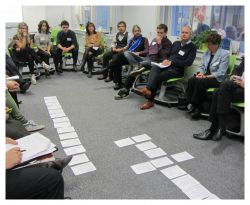
Below you will find a series of case studies of priority setting in action from a range of Cochrane Review Groups.
If you have examples of Prioritisation work that you would like to share, please contact support@cochrane.org.
 Pragmatic priority setting processes in Urology
Pragmatic priority setting processes in Urology
Cochrane Urology
Aim: To generate a list of priority topics of interest to our external stakeholders within our editorial scope.
Stakeholders: 99 urological associations worldwide available at the American Urological Association website.
Approach: Analysis of portfolio and impact measurement and consulted internal (editors) and external stakeholders.
Date: 2020-2022
Read More: Detailed information about the project and results has been published here.
 Obesity Gap Analysis and Prioritisation
Obesity Gap Analysis and Prioritisation
Cochrane Abdomen & Endocrine and Public Health & Health Systems Networks
Aim: Our aims were to produce a comprehensive list of obesity titles published in the Cochrane Library, to map these to international consensus documents and establish evidence gaps, and to consult with key external stakeholders to identify priority titles in the field of obesity.
Stakeholders: The stakeholders who responded to our consultation included guideline developers, clinicians, public health professionals, researchers, policymakers, research funders and consumers.
Date: 2019-2023
Read More: Detailed information about the project and results has been published here.
 Cochrane Review Group Network’s Health Equity Priority Setting Pilot
Cochrane Review Group Network’s Health Equity Priority Setting Pilot
Aim: To pilot a priority setting exercise on the theme of health equity across Cochrane Review Group Networks, identifying high priority Cochrane reviews to update with health equity methodology.
Stakeholders: A group of international stakeholders from across Cochrane and partner organizations, involving individuals in Argentina, Cameroon, Canada, Germany, India, Lebanon, South Africa, United Kingdom, and the United States of America.
Approach: We identified Cochrane reviews focused on conditions with a high global burden of disease from the 2019 WHO Global Burden of Disease report. We shortlisted Cochrane reviews focusing on mortality as the primary outcome and showing a beneficial intervention. Stakeholders prioritised reviews that were relevant to low-and middle-income countries. Publication of this project is expected in 2022 and the protocol for the project is linked below.
Date: Spring 2021.
Read More
 Overview of different priority setting exercises in Cochrane
Overview of different priority setting exercises in Cochrane
Cochrane Gynaecological, Neuro-oncology and Orphan Cancers
Aim: To set systematic review priority topics to ensure that the Gynaecological, Neuro-oncology and Orphan Cancers (GNOC) Group is producing reviews which are most relevant to those who use them e.g. consumers, policy makers, health care professionals, researchers, guideline developers.
Stakeholders: Charities, governmental organisations, individuals, policy makers, researchers.
Approach: Over the past twelve years the GNOC Group has been involved in five formal prioritisation exercises, including in-house exercises, James Lind Alliance Priority Setting Partnerships (JLA PSPs) and prioritisation of review updates. The Group has worked to engage with the end-users of reviews at an early stage in review production process to agree the top priority topics in the areas of gynae-oncology, neuro-oncology, rare cancers and aspects of the care for people with cancer.
Date: From 2007 to present day
Read More
Pragmatic priority setting processes in fertility regulation
Cochrane Fertility Regulation
Aim: To identify potential priority questions and evidence gaps in the Cochrane Fertility Regulation Review Group portfolio
Stakeholders: Global topic-specific organisations and respondents to an open online survey
Approach: After a review of the Review Group portfolio and literature search to identify potential new studies, a virtual stakeholder meeting was held to agree on some potential priority areas. These themes were developed into an online survey where respondents could identify their top five priorities from the list, and were given the opportunity to add other priority themes that weren't included in the existing list. The prioritisation process for contraceptive methods took five months.
Date: 2018-2019
Watch the Learning Live Webinar
Read More about the Contraception Prioritisation process
Read More about the Abortion Prioritisation process
Priority setting with consumers using web-based surveys
Cochrane Epilepsy and Cochrane Movement Disorders
Aim: To refine topics related to intervention and care. The secondary aim was to gather information on aspects which are important to stakeholders including outcomes, or other aspects of care which should be considered within systematic reviews.
Stakeholders: consumers through topic relevant patient organisations
Approach: Worked with editorial team and patient organisations to develop web-based survey for consumers. The surveys were advertised through the patient organisations' networks of consumers. The surveys allowed participants to choose five priority topics and provide information of why these were important. The results from the two different surveys were very different and had different challenges.
Date: 2018
Watch the Learning Live Webinar
Read More about the Movement Disorders Prioritisation process
Read More about the Epilepsy Prioritisation process
 Priority setting focusses editorial base support
Priority setting focusses editorial base support
Cochrane Skin
Aim: To prioritise unanswered questions in areas where there is a high global burden of diseases, rather than trying to cover all of dermatology.
Stakeholders: Twenty different stakeholder groups, including WHO, international dermatology associations and national guideline development group centres. Stakeholder groups were from across the world and included condition specific organisations.
Approach: Stakeholders were initially asked to identify their top priorities which were then reviewed by the editorial team. These lists were compiled alongside the evidence of the global burden of disease. Seven topics were identified as priority reviews. These will be the major focus for the Cochrane Skin editorial team in the future.
Date: 2018
Read More
 20th anniversary prioritisation workshop
20th anniversary prioritisation workshop
Cochrane Tobacco Addiction
Aim: To complete an in-depth prioritisation process to identify a list of high priority questions.
Stakeholders: People who smoked / had smoked in the past, healthcare professionals, policymakers, service commissioners, research funders and tobacco addiction researchers.
Approach: Online survey to generate questions, mapping questions through identification of existing evidence to develop categories, Delphi method to identify priorities, and workshops led by an independent facilitator for final decision making.
Date: 2016
Read more about the original prioritisation process
UPDATE! Read more about what has happened since prioritisation
 Targeting consumers on World Heart Day
Targeting consumers on World Heart Day
Cochrane Heart
Aim: To help the group decide on new topics for future reviews and to make existing reviews more relevant by identifying patient-relevant outcomes that might have been missed.
Stakeholders: Consumers, clinicians, guideline makers and members of general public identified through connections with the World Heart Foundation
Approach: Online survey allowing people to ask questions in order to identify topics for priority reviews.
Date: 2016
Read More
 Priority setting in a low / middle income country
Priority setting in a low / middle income country
Cochrane Sexually Transmitted Infections
Aim: To identify questions and evidence gaps in the area of sexually transmitted infections (STI).
Stakeholders: STI experts and organisations from both high income countries and low and middle income countries.
Approach: Evidence mapping of trial reports followed by an online survey allowing each stakeholder to identify top four STI questions.
Date: 2016
Read More
 Working with guideline developers
Working with guideline developers
Cochrane Incontinence
Aim: To identify gaps in their topic list and to develop a list of reviews that would meet the needs of this important stakeholder group.
Stakeholders: Guideline developers
Approach: European Associate on Urology panel on incontinence reviewed list of current Cochrane reviews to provide input on reviews that might be missing may need to be updated.
Date: 2016
Read More
 A wide-ranging prioritisation process for generating and prioritising new and update review topics
A wide-ranging prioritisation process for generating and prioritising new and update review topics
Cochrane Consumers and Communication Group
Aim: To develop a list of the 5 top priorities which reflect the important questions, to increase capacity to meet stakeholders needs and to foster stronger engagement with stakeholder groups.
Stakeholders: Stakeholders were invited to complete an initial survey. Stakeholders included individual patients and carers, patient groups, government health departments, medical and nursing colleges and researchers.
Approach: An international on-line survey of stakeholders to generate ideas for topics which were then organised into broad research topics. The topics were narrowed through a priority setting workshop which included 28 participants, of which 50% were consumers or carers. Of the 12 remaining topics after the workshop, five were identified and included onto the priority review list.
Date: 2016
Read More
Watch a presentation of the case study from the Cochrane colloquium.
Further examples of prioritisation work completed by Cochrane Groups can be found on Priority Setting Methods Group website.

